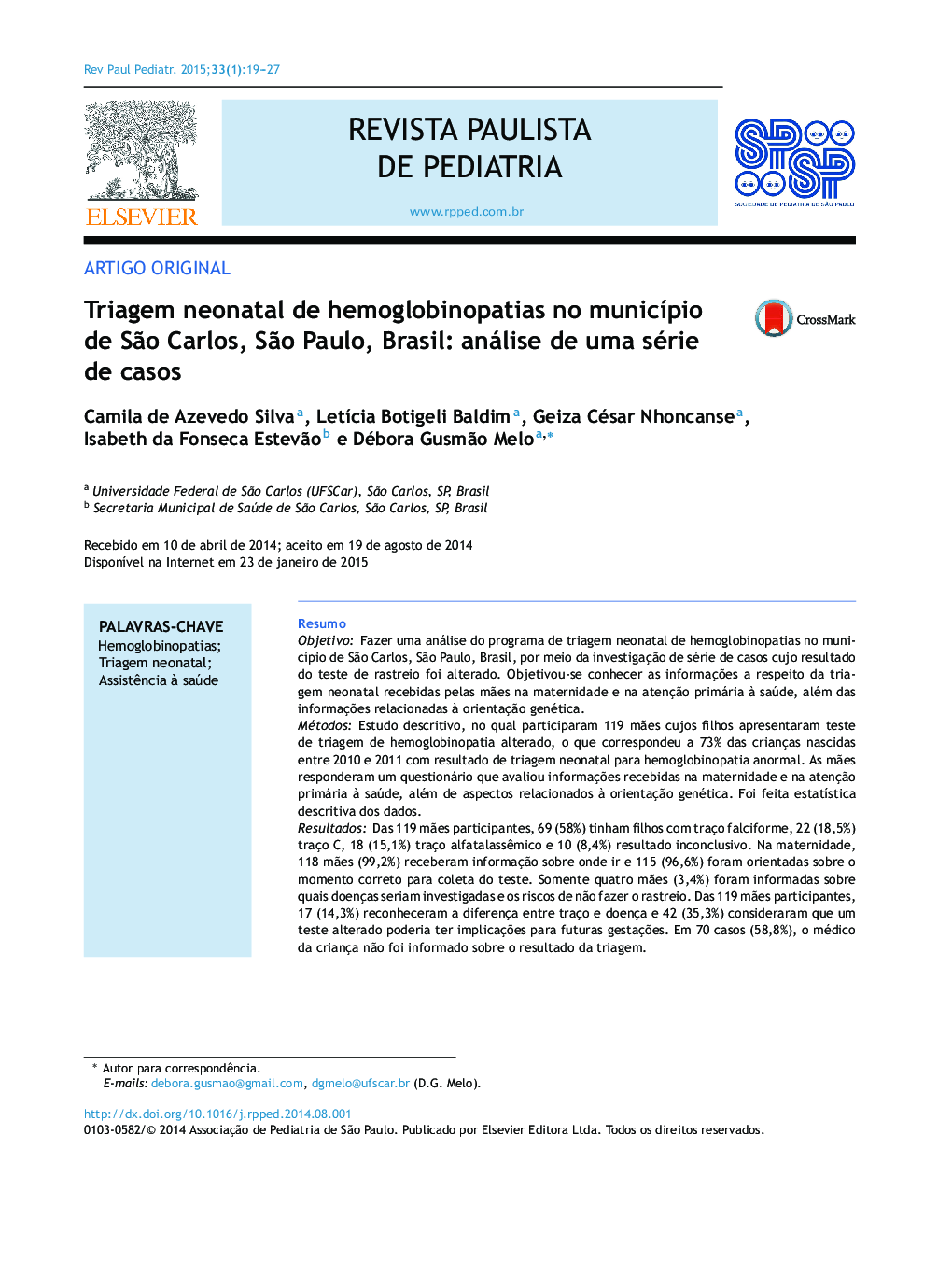| کد مقاله | کد نشریه | سال انتشار | مقاله انگلیسی | نسخه تمام متن |
|---|---|---|---|---|
| 4176020 | 1276230 | 2015 | 9 صفحه PDF | دانلود رایگان |

ResumoObjetivoFazer uma análise do programa de triagem neonatal de hemoglobinopatias no município de São Carlos, São Paulo, Brasil, por meio da investigação de série de casos cujo resultado do teste de rastreio foi alterado. Objetivou‐se conhecer as informações a respeito da triagem neonatal recebidas pelas mães na maternidade e na atenção primária à saúde, além das informações relacionadas à orientação genética.MétodosEstudo descritivo, no qual participaram 119 mães cujos filhos apresentaram teste de triagem de hemoglobinopatia alterado, o que correspondeu a 73% das crianças nascidas entre 2010 e 2011 com resultado de triagem neonatal para hemoglobinopatia anormal. As mães responderam um questionário que avaliou informações recebidas na maternidade e na atenção primária à saúde, além de aspectos relacionados à orientação genética. Foi feita estatística descritiva dos dados.ResultadosDas 119 mães participantes, 69 (58%) tinham filhos com traço falciforme, 22 (18,5%) traço C, 18 (15,1%) traço alfatalassêmico e 10 (8,4%) resultado inconclusivo. Na maternidade, 118 mães (99,2%) receberam informação sobre onde ir e 115 (96,6%) foram orientadas sobre o momento correto para coleta do teste. Somente quatro mães (3,4%) foram informadas sobre quais doenças seriam investigadas e os riscos de não fazer o rastreio. Das 119 mães participantes, 17 (14,3%) reconheceram a diferença entre traço e doença e 42 (35,3%) consideraram que um teste alterado poderia ter implicações para futuras gestações. Em 70 casos (58,8%), o médico da criança não foi informado sobre o resultado da triagem.ConclusõesO programa de triagem neonatal necessita de aperfeiçoamento. Nos dois cenários investigados, os profissionais de saúde carecem de treinamento para orientar mães e famílias.
ObjectiveTo analyze the neonatal screening program for hemoglobinopathies in Sao Carlos, Sotheast Brazil, by investigating a series of cases which the screening test was abnormal. More specifically, it was aimed to know the information regarding the neonatal screening received by mothers at hospital and at primary health care, in addition to information related to genetic counseling.MethodsA descriptive study that enrolled 119 mothers, accounting for 73% of all children born between 2010 and 2011 with abnormal results of neonatal screening for hemoglobinopathies. The mothers completed a questionnaire that assessed the information received at hospital and primary health care, and issues related to genetic counseling. Descriptive statistics was performed.ResultsAmong the 119 participating mothers, 69 (58%) had children with sickle cell trait, 22 (18.5%) with hemoglobin C trait, 18 (15.1%) with alpha thalassemia trait and, in 10 cases (8.4%), the result was inconclusive. At hospital, 118 mothers (99.2%) received information about where to go to collect the test and 115 (96.6%) were oriented about the correct time to collect the test. Only 4 mothers (3.4%) were informed about which diseases are investigated and the risks of not performing the screening. Seventeen mothers (14.3%) recognized the difference between trait and disease, and 42 (35.3%) considered that a positive screening test could have implications for future pregnancies. In 70 cases (58.8%), the child physician was not informed about the screening test results.ConclusionsThe neonatal screening program need further improvement. In both scenarios investigated, health professionals demonstrated a lack of training in guiding mothers and families.
Journal: Revista Paulista de Pediatria - Volume 33, Issue 1, March 2015, Pages 19–27